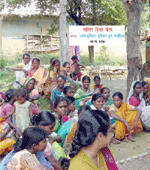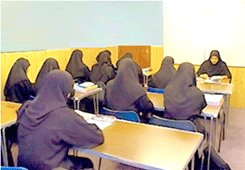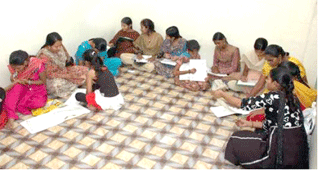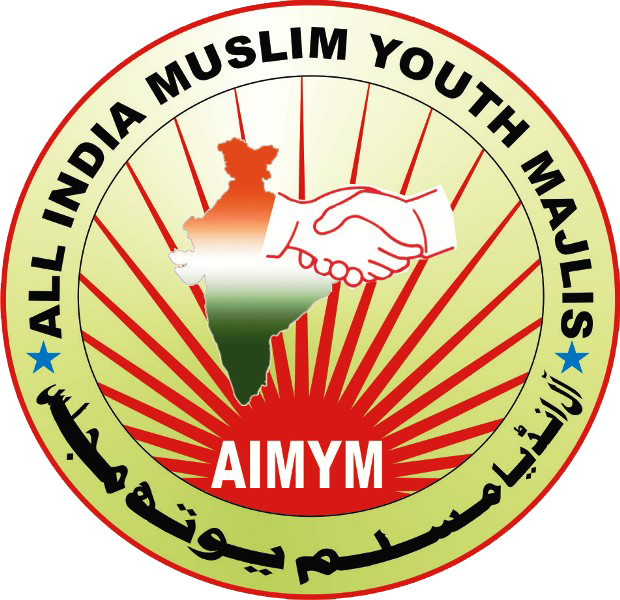| |
In urban areas, the literacy level of Muslimwomen is 47 percent. In rural areas, it is 32 per cent. Only 2 to 3 percent of the Muslim girls between 7 and 16 years are able to go to school. Most of them go to madarsas only.
Above are some facts on the plight of Muslim women in the state as observed by the Sacchar Committee. The report might have highlighted the plight but organisations and NGOs working for their welfare feel that there are a lot of loopholes, which need immediate attention.
The All India Muslim Youth Majlis have done a survey on the conditions of Muslim women in 12 urban slums in Bihar in year 2005.
Of the 500 women, who were taken as a sample, only eight were graduates, sixteen had passed secondary and 60 had passed Class VIII. The rest were uneducated. Two hundred fourty women said that their children don’t go to school. Although the state and the Union government have a number of scholarship schemes for the children of minority communities, none of the children who are studying in school are beneficiaries of any scholarship. None of the girls in these slums go to schools as there are no schools in their neighbour hood, this ration decrease after the formation of new Government in Bihar from November 2005.
The recommendations include recognising wards and panchayats where Muslims are a majority, training centre to provide livelihood options, a minority member in all selection boards, residential schools for Muslim girls.
|
|
| |
This is the first such survey of this magnitude, covering the whole country, and obviously therefore, the findings deserve attention. But perhaps even more interesting than the results themselves are the insights that are drawn into the interplay of various factors that determine the conditions of Muslim women's lives.
Of course, there are some easily predictable conclusions, especially with respect to economic status. The low socio-economic status of Muslims is now well known; like the Scheduled Castes, they are disproportionately represented among the poor and have the lowest per capita income indicators. This is a scribed not only to the lack of access to asset ownership, but also to poor educational attainment and occupational patterns, which show clustering in low-paid activities, as well as the concentration of the Muslim population in the economically backward regions of the country.
This economic differentiation constitutes probably the primary source of differentiation in status between Muslim and Hindu women in the aggregate, since the household's level of assets ownership, occupation and income possibilities critically determine the basic conditions of life of the women. However, there are significant regional differences in this: Muslims are generally poor in the north (especially rural areas) and the east, but less so in the south.
But other findings of the study are much less predictable, and do much to demolish the damaging stereotypes that are so widely purveyed about Muslim women.
One of the standard assumptions about Muslim women is that religion prevents them from getting more equal access to education. It is certainly true that Muslim women are more likely to be illiterate than Hindu women (in the survey, 59 per cent had never attended school and less than 10 per cent had completed school). However, the study shows that this is essentially the result of low socio-economic status, rather than religion. Across the survey, among all communities and caste groups, financial constraints and gender bias dominate over other factors in determining levels of education. Indeed, in those regions where Muslims are better off (as in the south and to a lesser extent in the west), Muslim women also have higher levels of education.
Under the banner of All India Muslim Youth Majlis madrasa is already running here in Bihar,where poor muslim boys and girls getting Islamic education and modern education,students get computer knowledge also from here.
However, two other features that are more specific to the Muslim community may have operated to devalue continuing education for girls. The first is that Muslim men also have very low educational attainment in general. The study found that 26 per cent of educated Muslim women had illiterate husbands. This low male education level would create further pressures to impose ceilings on girls' education, so as not to render them "unmarriageable". In addition, the low age of marriage is a major inhibiting factor. At the national level, the mean age of marriage of Muslim girls is very low at 15.6 years, and in the rural north it falls to an appalling 13.9 years.
Low marriage age has a number of other adverse implications: it is usually associated with high early fertility, which affects women's nutrition and health status; it tends to reduce women's autonomy and agency in the marital home and to create conditions of patriarchal subservience that get perpetuated through life, and it thereby often reduces self-worth.
This, in turn, may affect women's work participation in direct and indirect ways. It is well known that the work participation of Muslim women is very low, but the study indicates that this may be less due to the force of religion per se than to the patriarchal structures and patterns as well as low mobility and lack of opportunity that define their  lives. It is worth noting that the work participation rate of women across communities tends to be low in certain regions, especially in the north and the east. lives. It is worth noting that the work participation rate of women across communities tends to be low in certain regions, especially in the north and the east.
Some of this is due to straightforward control over women's agency by male members of the household. Seventy five per cent of the women in the survey (both Hindu and Muslim) reported that they need permission from their husbands to work outside the home. Interestingly, the study revealed that across the board women in India tend to have relatively less autonomy of decision-making within the household.
Less than 10 per cent of the respondents took any decisions on their own in major or minor matters, and among the 30 per cent who took decisions jointly with their husbands, Muslim women reported greater consultation than Hindus for all categories of decisions. Clearly, however, patriarchal control remains one important constraint upon the outside work of women, among Muslims as well as certain other social categories.
But in addition, most of the outside work that the representative Muslim woman has access to falls in the lowest paid and most exploited categories of labour. Such activities - self-employed in low-productivity activities in the informal sector, as casual labourers and domestic servants - imply poor working conditions and low wages. It is, therefore, possible that Muslim women are kept out of the paid workforce not only by religious or pardah type motivations, but perhaps more significantly by low education, lack of opportunity, low mobility and the inability to delegate domestic responsibilities.
In terms of domestic violence - which is widely recognised to be increasing in India - the incidence cuts across caste, class and community. The survey finds that over 50 per cent of the reported violence (which may, of course, be different from the actual incidence of violence) is among the Scheduled Caste and the Scheduled Tribe households, which also happen to be the poorest of the poor. Muslim women come in third (after Other Backward Castes) at 18 per cent. What is possibly more significant is that husbands were identified as the primary perpetrators in more than 80 per cent of cases.
EFFECTIVELY, what this study shows is that Hindu-Muslim differences in patterns of marriage, autonomy, mobility and domestic violence are insignificant. There is no apparent community-wise variation in women's decision-making, mobility and access to public spaces. Rather, what the survey indicates is that most women in India - across communities and regions - have very little autonomy and control over their own lives. Of course, such constraints are not felt equally by all women, but the distinctions are determined more by class and geographical location than by community. Indeed, regional development appears to be a better predictor of the status of women and "Muslimness" or religion per se.
These are obviously extremely important results, which point to a different direction for public policy as well. There are clear indications of the need for a new, less predetermined conception of community and especially of the status of women within a community. This would go beyond the patterns of special group recognition, in which notions of "identity" (however patriarchal) are maintained at all costs. It would also have to avoid getting bogged down by controversies over claims of the minorities of enhanced representation in government jobs and the like.
Rather, the social and economic processes that confront marginal groups in general need to be addressed - to enable greater real democracy across different social groups and across gender within social groups.
|
|









 lives. It is worth noting that the work participation rate of women across communities tends to be low in certain regions, especially in the north and the east.
lives. It is worth noting that the work participation rate of women across communities tends to be low in certain regions, especially in the north and the east.

